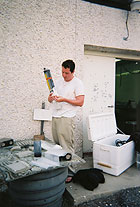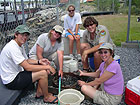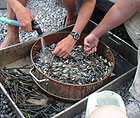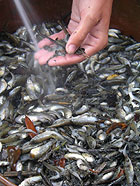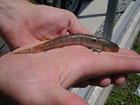

 | |||||||||||||||||
|
|
Journals 2006/2007Anna Hilton
July 19, 2006 (Part 2)
When we returned to the Marine Extension Service Station, Travis immediately took the sondes from each order into the lab to clean them. Travis cleaned and packed all of the sondes for the trip back to Charleston. Kolo had already begun processing his oyster sample from Burnett Creek. The other teams had arrived earlier and were in the middle of cleaning their equipment and preparing the biota samples caught by trawl and seine in the both orders of Burnett Creek.
This involved putting everything caught at a reach in the seine into a large sieve. Several students worked together carefully rinsing away the mud and picking out the tiny shrimp, crabs, and fish.
These were then put into a large plastic container which was labeled by reach number and date. These biota samples are kept cold until they are identified and counted back at Hollings Marine Laboratory. I was surprised how hard the researchers work at processing the samples.
Patrick was the expert at identifying any unusual fish by their scientific names.
Lisa, Mark, and I were the last team to arrive at the lab so the other researchers pitched in to help us clean our catch. I had to grin to myself when Lisa handed the plastic sample bag containing what I knew to have the awful odor to Cindy and Angela to process. Lisa and Mark laughed out loud when their noses noticed. Finally processing and packing the U-Haul was done. We washed up in the lab, decided to dine at Wendy's on the way back to Hollings Marine Laboratory in Charleston. I don't remember enjoying fast food so much! |
||||||||||||||||
